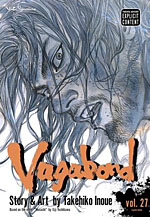 By Takehiko Inoue
By Takehiko Inoue
208 pages, black and white
Published by Viz
2008 appears to be the year that Takehiko Inoue gets a huge push in North America. Viz is bringing his new series Real into English, as well as reviving Slam Dunk (which was part of Gutsoon Publishing’s now-defunct English-language publishing line). Two Inoue art books are scheduled for this year, as well as adding Vagabond to the VizBig collected editions line. It’s worth nothing, though, that for those who are already know when it comes to Inoue, Vagabond‘s been published for several years now in English. And, quite frankly, it’s the best series out of Japan currently being translated.
Miyamato Musashi is up against truly impossible odds, all 70 students of the Yoshioka school who are preparing to ambush Musashi in revenge for the death of their two masters. And rather than avoid them, Musashi has decided to stop hiding and running, instead taking them all on. What should be impossible, though, will prove to be anything but.
What amazed me about Vagabond Vol. 26-27 is that for being a two-volume bloodbath, there is a lot more to these books than just killing. It serves not only as a battle for Musashi, but as a meditative time. Reflecting on his life and where it is going is one of the central pieces of this struggle for Musashi. Early on he tells himself, “Have no aspirations for the future. Lean neither forward nor backwards. Repeat this moment of the present over and over again.” As the battle progresses, he tells himself to find the flow, thinking, “Life itself finds a path, the path towards survival.” It’s this strategy that in many ways keeps him alive, focusing less on the sheer numbers against him and more being in the moment, a zen-like grace on the situation at hand, gliding through the carnage and out to the other side.
Don’t get me wrong, though, Vagabond Vol. 26-27 is incredibly bloody. Inoue starts Musashi looking clean and near-pristine, but all of that changes with the first death. While the blood and gore is never gratuitous, it is certainly present for every step of the way through this fight. Musashi himself grows increasingly dirty and mussed as it progresses; his hair becomes wilder, sweat and blood start to coat his body, and his clothes develop rips and tears. There is never any glamorizing what goes on here from Inoue; this is a dirty, filthy, brutal behavior that is shown in fine detail, using Inoue’s delicate-lined art style.
While Vagabond is based off of Eiji Yoshikawa’s novel Musashi, Inoue is able to bring so much more to the story through his adaptation. Not only does he delve much deeper into everyone’s heads, but the added visual cues provided through Inoue’s art are invaluable in helping the story of Musashi’s come together. There are almost no other books I could say this, but this is the exception to the rule: Vagabond is a perfect comic. I’m looking forward to seeing Real for the first time, as well as looking back and re-discovering Slam Dunk. That said, I know Vagabond will always pull me back for more. Highly recommended.
Purchase Links:
